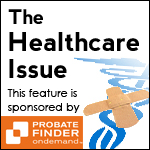It was another active year within the healthcare vertical of the ARM industry. Notwithstanding federal insurance reform efforts in Washington, strategic and industry buyers were out in numbers looking for add-ons to existing platforms as well as those looking to land their first investment in our industry.
Healthcare M&A Stats
Here are some quick statistics from our proprietary completed deals database:
- In 2010 our firm tracked 36 completed transactions of which 10 were healthcare related compared to 2009 which had only six such transactions.
- Of the 10 healthcare related transactions in 2010, nine were completed by industry players and one by a strategic buyer.
Healthcare Reform
In March 2010, President Obama signed into law a landmark piece of federal legislation to revamp the U.S. healthcare system and to create a path to coverage for millions of previously uninsured Americans. But by November 2010, Republicans—many of whom had campaigned on a promise to repeal The Patient Protection and Affordable Care Act—had taken control of the House, bolstered their ranks in the Senate, and set about the work of dismantling the bill. In January the House voted to repeal the Act, a similar measure failed to garner enough votes in the Democrat-controlled senate.
Even as political scuffles continue in Washington, healthcare executives—and their service provider partners in the accounts receivable management (ARM) and revenue cycle management (RCM) industries—press on with the day to day business of healthcare.
 And investors are trying to figure out how to capitalize on business opportunities the new reform will create. It isn’t clear whether healthcare agencies will be negatively impacted by all of the proposed changes in the law, but one thing is fairly obvious: the collectability of the “self pay” collection bucket should improve as it is estimated that 32 million Americans will gain health insurance by 2019 if the law stands. And in spite of its sweeping nature, the bill does not address the billions of dollars of existing bad debt that’s negatively impacting the bottom line of hospital systems, group practices, clinics, and rehab centers across the United States.
And investors are trying to figure out how to capitalize on business opportunities the new reform will create. It isn’t clear whether healthcare agencies will be negatively impacted by all of the proposed changes in the law, but one thing is fairly obvious: the collectability of the “self pay” collection bucket should improve as it is estimated that 32 million Americans will gain health insurance by 2019 if the law stands. And in spite of its sweeping nature, the bill does not address the billions of dollars of existing bad debt that’s negatively impacting the bottom line of hospital systems, group practices, clinics, and rehab centers across the United States.
Outlook
We expect continued deal activity within healthcare. What will drive that activity will be larger healthcare agencies who may already be private equity backed who are looking to expand into new geographic markets and acquire additional services that they don’t provide today. We have found that most buyers are more interested in agencies with advanced capability for first party collection and less so on traditional bad debt. First party projects are more predictable from a cash flow perspective and are a better entré into other central business office servicing opportunities such as patient registration, staffing, front-end billing, and scoring & analytics. Healthcare ARM and RCM companies that provide diverse service offerings are in demand from hospital CFOs—it follows that they would attract similar interest from potential buyers looking to capitalize on these strategic advantages.
Want to discuss the healthcare ARM market? Give me a call or shoot me an email.
 Michael D. Lamm advises owners on their growth and exit strategies for Kaulkin Ginsberg’s Strategic Advisory team. Michael can be reached directly from Kaulkin Ginsberg’s Philadelphia office at 240-499-3808 or by email. You can also read his blogs on insideARM.com.
Michael D. Lamm advises owners on their growth and exit strategies for Kaulkin Ginsberg’s Strategic Advisory team. Michael can be reached directly from Kaulkin Ginsberg’s Philadelphia office at 240-499-3808 or by email. You can also read his blogs on insideARM.com.




![Michael Lamm [Image by creator from ]](/media/images/michael-lamm.2e16d0ba.fill-500x500.jpg)

![[Image by creator from ]](/media/images/2015-04-cpf-report-training-key-component-of-s.max-80x80_F7Jisej.png)


![[Image by creator from ]](/media/images/New_site_WPWebinar_covers_800_x_800_px.max-80x80.png)
![[Image by creator from ]](/media/images/Finvi_Tech_Trends_Whitepaper.max-80x80.png)
![[Image by creator from ]](/media/images/Collections_Staffing_Full_Cover_Thumbnail.max-80x80.jpg)
![Report cover reads One Conversation Multiple Channels AI-powered Multichannel Outreach from Skit.ai [Image by creator from ]](/media/images/Skit.ai_Landing_Page__Whitepaper_.max-80x80.png)
![Report cover reads Bad Debt Rising New ebook Finvi [Image by creator from ]](/media/images/Finvi_Bad_Debt_Rising_WP.max-80x80.png)
![Report cover reads Seizing the Opportunity in Uncertain Times: The Third-Party Collections Industry in 2023 by TransUnion, prepared by datos insights [Image by creator from ]](/media/images/TU_Survey_Report_12-23_Cover.max-80x80.png)
![Webinar graphic reads RA Compliance Corner - Managing the Mental Strain of Compliance 12-4-24 2pm ET [Image by creator from ]](/media/images/12.4.24_RA_Webinar_Landing_Page.max-80x80.png)